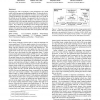Free Online Productivity Tools
i2Speak
i2Symbol
i2OCR
iTex2Img
iWeb2Print
iWeb2Shot
i2Type
iPdf2Split
iPdf2Merge
i2Bopomofo
i2Arabic
i2Style
i2Image
i2PDF
iLatex2Rtf
Sci2ools
VR
2009
IEEE
2009
IEEE
An Image-Warping Architecture for VR: Low Latency versus Image Quality
Designing low end-to-end latency system architectures for virtual reality is still an open and challenging problem. We describe the design, implementation and evaluation of a client-server depth-image warping architecture that updates and displays the scene graph at the refresh rate of the display. Our approach works for scenes consisting of dynamic and interactive objects. The end-to-end latency is minimized as well as smooth object motion generated. However, this comes at the expense of image quality inherent to warping techniques. We evaluate the architecture and its design trade-offs by comparing latency and image quality to a conventional rendering system. Our experience with the system confirms that the approach facilitates common interaction tasks such as navigation and object manipulation.
Depth-image Warping Architecture | End-to-end Latency | Low End-to-end Latency | Virtual Reality | VR 2009 |
| Added | 21 May 2010 |
| Updated | 21 May 2010 |
| Type | Conference |
| Year | 2009 |
| Where | VR |
| Authors | Ferdi A. Smit, Robert van Liere, Stephan Beck, Bernd Fröhlich |
Comments (0)

